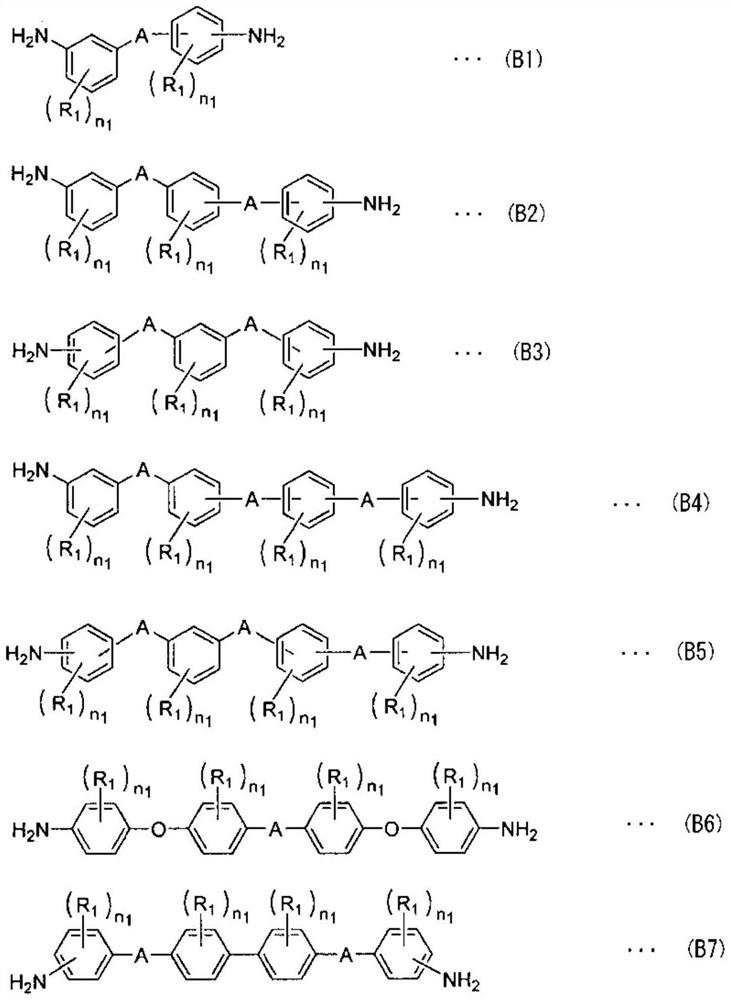Polyimide film, copper sheet laminate, and circuit board
A polyimide layer, polyimide film technology, applied in the direction of circuit substrate materials, printed circuits, printed circuits, etc., can solve the problem of large dimensional change rate of polyimide film, insufficient dielectric properties, linear expansion Large coefficient and other problems, to achieve excellent dimensional stability, low hygroscopicity and dielectric tangent, and achieve the effect of low hygroscopicity
- Summary
- Abstract
- Description
- Claims
- Application Information
AI Technical Summary
Problems solved by technology
Method used
Image
Examples
Embodiment
[0214] An Example is shown below, and the characteristic of this invention is demonstrated more concretely. However, the scope of the present invention is not limited to the Examples. In addition, in the following examples, unless otherwise specified, various measurements and evaluations were performed by the following ones.
[0215] [Measurement of Viscosity]
[0216] The viscosity at 25°C was measured using an E-type viscometer (manufactured by Brookfield, trade name: DV-II+Pro). The rotational speed was set so that the torque would be 10% to 90%, and the value when the viscosity was stabilized was read after 2 minutes elapsed after the measurement was started.
[0217] [Measurement of glass transition temperature (Tg)]
[0218] Regarding the glass transition temperature, using a dynamic viscoelasticity measuring apparatus (DMA: UBM Co., Ltd., trade name: E4000F), from 30° C. to 400° C. at a temperature increase rate of 4° C. / min and a frequency of 11 Hz, 5 mm×20 mm The ...
Synthetic example A-1
[0259] Under a nitrogen stream, 1.335 g of m-TB (0.0063 mol), 10.414 g of TPE-R (0.0356 mol), and DMAc in such an amount that the solid content concentration after polymerization was 12% by weight were put into a 300-ml separable flask. Stir and dissolve at room temperature. Next, after adding 0.932 g of PMDA (0.0043 mol) and 11.319 g of BPDA (0.0385 mol), stirring was continued at room temperature for 3 hours to perform a polymerization reaction to obtain a polyamic acid solution A-1. The solution viscosity of the polyamic acid solution A-1 was 1,420 cps.
[0260] Next, after the polyamic acid solution A-1 was uniformly applied to one side (surface roughness Rz: 2.1 μm) of an electrolytic copper foil having a thickness of 12 μm so that the thickness after hardening would be about 25 μm, it was heated at 120° C. drying under heat and solvent removal. Furthermore, a stepwise heat treatment is performed from 120° C. to 360° C. within 30 minutes to complete imidization. About ...
Synthetic example A-2
[0262] Under a nitrogen stream, 0.451 g of m-TB (0.0021 mol), 11.794 g of TPE-R (0.0403 mol), and DMAc in an amount such that the solid content concentration after polymerization was 12 wt % were put into a 300-ml separable flask. Stir and dissolve at room temperature. Next, after adding 2.834 g of PMDA (0.0130 mol) and 8.921 g of BPDA (0.0303 mol), the polymerization reaction was continued at room temperature for 3 hours while stirring to obtain a polyamic acid solution A-2. The solution viscosity of the polyamic acid solution A-2 was 1,510 cps.
[0263] Next, after the polyamic acid solution A-2 was uniformly applied to one side (surface roughness Rz: 2.1 μm) of an electrolytic copper foil having a thickness of 12 μm so that the thickness after hardening would be about 25 μm, it was heated at 120° C. drying under heat and solvent removal. Furthermore, a stepwise heat treatment is performed from 120° C. to 360° C. within 30 minutes to complete imidization. About the obtain...
PUM
| Property | Measurement | Unit |
|---|---|---|
| glass transition temperature | aaaaa | aaaaa |
| thickness | aaaaa | aaaaa |
| thickness | aaaaa | aaaaa |
Abstract
Description
Claims
Application Information
 Login to View More
Login to View More - R&D
- Intellectual Property
- Life Sciences
- Materials
- Tech Scout
- Unparalleled Data Quality
- Higher Quality Content
- 60% Fewer Hallucinations
Browse by: Latest US Patents, China's latest patents, Technical Efficacy Thesaurus, Application Domain, Technology Topic, Popular Technical Reports.
© 2025 PatSnap. All rights reserved.Legal|Privacy policy|Modern Slavery Act Transparency Statement|Sitemap|About US| Contact US: help@patsnap.com



